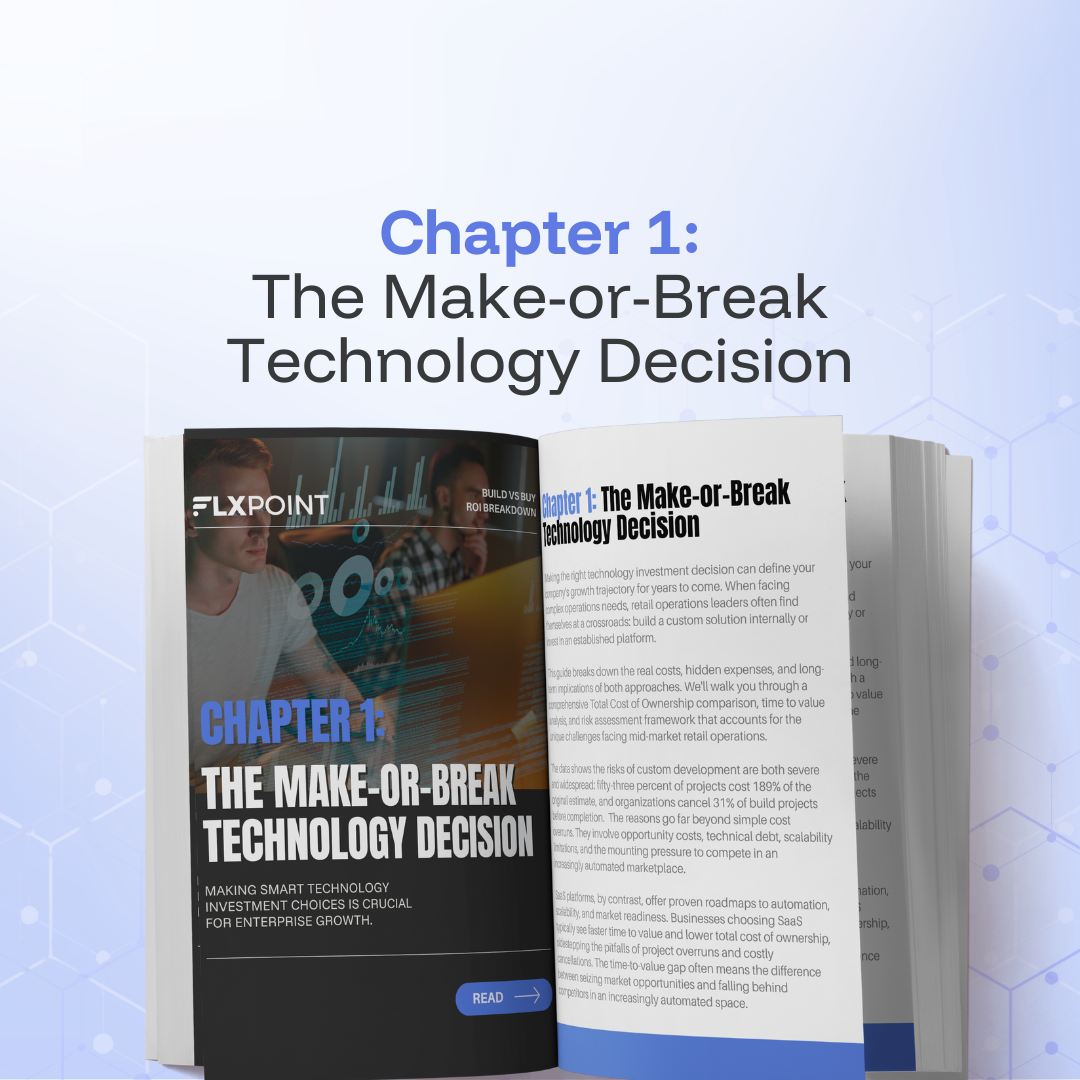Chapter 5 Implementation Strategy
Successful platform adoption requires strategic phased implementation: assessment, pilot testing, gradual expansion, and full production. Effective change management includes team training, process standardization, and stakeholder communication. Ongoing optimization and success metrics ensure maximum ROI and operational excellence.
.png?width=1080&height=1080&name=Build%20vs%20Buy%20ROI%20Breakdown%20(5).png)
Success with ecommerce automation platforms requires strategic implementation that maximizes value while minimizing risk. Companies that achieve the best results follow proven methodologies for migration planning, change management, and optimization.
Migration Planning
Transitioning from manual processes or legacy systems to automation platforms demands careful coordination to avoid business disruption. The most successful implementations follow a phased approach that validates functionality before committing fully.
Phase 1: Assessment and Planning
Start with comprehensive mapping of current processes, data sources, and integration requirements. This discovery phase identifies potential challenges before they impact operations.
Key assessment activities include:
- Data inventory: Catalog all product, inventory, and order data sources
- Integration mapping: Document current systems and required connections
- Process documentation: Map existing workflows and decision points
- Success metrics definition: Establish measurable goals for the implementation
- Risk assessment: Identify potential points of failure and mitigation strategies
Stetson's Herschel Thompson appreciated thorough planning: "The team at Flxpoint has been incredibly responsive and helpful throughout the implementation process. They've gone above and beyond to make sure we're getting the most out of the platform." Professional implementation planning prevents costly mistakes and ensures smooth transitions.
Phase 2: Pilot Implementation
Begin with a limited subset of products, vendors, or sales channels to validate the platform configuration. This approach allows refinement without risking full operations.
Pilot implementation includes:
- Single vendor integration: Start with your most reliable supplier
- Limited product catalog: Test with 100-500 SKUs initially
- Single sales channel: Focus on your primary marketplace or storefront
- Order processing validation: Verify all workflows function correctly
- Performance monitoring: Establish baseline metrics for expansion
Phase 3: Gradual Expansion
Systematically add vendors, products, and channels based on pilot success. This controlled expansion maintains stability while building comprehensive coverage.
Expansion priorities typically follow this order:
- High-volume vendors: Suppliers that represent the most orders
- Reliable data sources: Vendors with consistent, clean data feeds
- Strategic channels: Sales platforms with growth potential
- Complex integrations: EDI and custom API connections last
Phase 4: Full Production
Complete the migration by bringing all remaining vendors, products, and channels into the platform. Monitor performance closely and optimize configurations based on actual usage patterns.
Full production includes:
- Complete vendor network: All suppliers integrated and operational
- Full product catalog: Entire SKU range available through automation
- All sales channels: Every marketplace and storefront connected
- Advanced features: Routing rules, pricing automation, and reporting fully configured
- Performance optimization: Fine-tuning based on real-world usage data
Change Management
Successful platform adoption requires more than technical implementation—it demands organizational change management that ensures user adoption and operational excellence.
Team Preparation and Training
The most common implementation failures stem from inadequate user preparation. Teams accustomed to manual processes need structured training and ongoing support to embrace automation effectively.
Training components should include:
- Platform overview sessions: Help teams understand capabilities and benefits
- Role-specific training: Customize instruction for different user types
- Hands-on workshops: Practice with real data and scenarios
- Documentation and resources: Accessible reference materials for ongoing use
- Champions program: Identify and train power users who can support others
Process Documentation and Standardization
Automation reveals inconsistencies in manual processes that must be addressed for optimal results. Use implementation as an opportunity to standardize and improve workflows.
Process standardization includes:
- Workflow documentation: Clear procedures for common tasks
- Decision tree creation: Standardized logic for handling exceptions
- Quality control procedures: Validation steps to ensure data accuracy
- Escalation procedures: Clear paths for handling problems
- Performance standards: Measurable targets for operational excellence
Stakeholder Communication
Platform implementation affects multiple departments and external partners. Maintain clear communication throughout the process to ensure alignment and support.
Communication strategies include:
- Regular status updates: Weekly progress reports for key stakeholders
- Impact assessments: Clear explanation of how changes affect different groups
- Training schedules: Advance notice of required training sessions
- Go-live communications: Detailed instructions for the transition period
- Feedback channels: Ways for users to report issues and suggestions
Success Metrics
Measuring implementation success requires both quantitative metrics and qualitative assessments. Establish baseline measurements before implementation and track progress regularly.
Operational Efficiency Metrics
These metrics measure the core benefits of automation: reduced manual work, fewer errors, and improved productivity.
Key efficiency metrics include:
- Time savings: Hours saved per day/week through automation
- Error reduction: Decrease in order processing mistakes
- Processing speed: Time from order receipt to fulfillment
- Productivity gains: Orders processed per team member
- Manual intervention rate: Percentage of orders requiring human touch
Discount Bowling Supply achieved measurable efficiency gains: "In my eyes, automation is the future, and in order to grow a business, you need automation these days. You can't sit there and hire employees to manually email over 300-400 orders a day." Their metrics showed dramatic reductions in manual workload.
Business Growth Metrics
Platform adoption should enable business growth through improved scalability and operational capacity.
Growth metrics include:
- Order volume growth: Increased capacity to handle more orders
- Revenue growth: Business expansion enabled by automation
- Vendor network expansion: Ability to onboard suppliers faster
- Channel diversification: Expansion into new sales channels
- Market responsiveness: Faster adaptation to opportunities
Customer Experience Metrics
Automation should improve customer experience through faster processing, fewer errors, and better inventory accuracy.
Customer metrics include:
- Order accuracy: Reduction in shipping and product errors
- Fulfillment speed: Faster order processing and shipping
- Inventory accuracy: Fewer stockouts and overselling incidents
- Customer service volume: Reduced support tickets due to fewer problems
- Customer satisfaction scores: Direct feedback on experience improvements
Financial ROI Metrics
Track the financial impact of platform adoption to validate investment decisions and optimize resource allocation.
ROI metrics include:
- Cost per order: Total operational cost divided by order volume
- Labor cost reduction: Savings from reduced manual work
- Error cost avoidance: Money saved by preventing mistakes
- Revenue per employee: Productivity gains enabling growth without proportional hiring
- Platform ROI: Total benefits compared to platform costs
Optimization Roadmap
Implementation success requires ongoing optimization based on real usage patterns and changing business requirements. Plan for continuous improvement rather than treating implementation as a one-time project.
Initial Optimization
Focus on stabilizing operations and addressing immediate performance issues discovered during initial usage.
Early optimization priorities:
- Data quality improvements: Clean up product information and vendor feeds
- Workflow refinements: Adjust processes based on user feedback
- Integration tuning: Optimize connection settings for performance
- User training reinforcement: Additional support for struggling users
- Quick wins identification: Easy improvements that deliver immediate value
Advanced Feature Adoption
Begin leveraging more sophisticated platform capabilities as teams become comfortable with basic functionality.
Advanced features typically include:
- Automated routing rules: Intelligent order routing based on multiple criteria
- Dynamic pricing: Automated price adjustments based on costs and competition
- Advanced reporting: Business intelligence and analytics capabilities
- API integrations: Custom connections to specialized systems
- Workflow automation: Eliminate remaining manual processes
Mindful's experience illustrates this progression: "Where we have seen Flxpoint help a lot is in reducing shipping costs, but also just reducing the manual work from our customer service team by not having to login and manage nearly as many orders." Advanced routing rules delivered both cost savings and operational efficiency.
Strategic Expansion
Use platform capabilities to enable strategic business initiatives that weren't possible with manual processes.
Strategic expansion opportunities include:
- New market entry: Geographic or demographic expansion enabled by automation
- Product line extensions: Faster onboarding of new suppliers and categories
- Channel diversification: Expansion into additional sales platforms
- Partnership programs: Dropship and reseller networks powered by automation
- Operational scaling: Growth without proportional overhead increases
Continuous Innovation
Establish ongoing processes for leveraging new platform capabilities and adapting to changing business requirements.
Long-term optimization includes:
- Feature adoption cycles: Regular evaluation and adoption of new capabilities
- Performance reviews: Quarterly assessments of metrics and improvements
- Process evolution: Continuous refinement based on business changes
- Technology integration: Adoption of emerging technologies and standards
- Strategic planning: Platform capabilities inform business strategy decisions
Risk Mitigation Strategies
Even well-planned implementations can encounter challenges. Prepare mitigation strategies for common risks to ensure project success.
Common Implementation Risks:
- Data migration issues: Corrupted or incomplete data transfers
- Integration failures: Third-party connections that don't work as expected
- User adoption resistance: Team members who resist changing established processes
- Performance problems: Platform response times that don't meet expectations
- Vendor cooperation issues: Suppliers who resist new processes
Mitigation Strategies:
- Comprehensive testing: Validate all functionality before go-live
- Rollback procedures: Ability to revert to previous systems if needed
- Change champions: Internal advocates who support user adoption
- Vendor communication: Clear explanation of benefits to external partners
- Support escalation: Direct access to platform experts for problem resolution
The key to successful implementation lies in treating it as a strategic initiative rather than a technical project. Companies that invest in proper planning, change management, and ongoing optimization achieve the best results from their platform adoption.
Conclusion: Making the Right Decision for Your Business
Custom development typically costs 2-3 times more than enterprise platforms over three years when you account for maintenance, security, and opportunity costs. Hidden expenses like downtime, training, and vendor management compound these costs while introducing operational risks.
Enterprise platforms deliver measurable advantages: proven reliability, built-in compliance, immediate integrations, and specialized support. When you apply the ROI framework from this guide, platforms typically show 30-50% better risk-adjusted returns than building custom solutions.
The strategic question is simple: where should your team focus their energy? Building and maintaining technology infrastructure, or growing your business and serving customers? Most successful ecommerce organizations choose platforms that handle technical complexity while their teams concentrate on revenue-generating activities.
Your decision impacts both current operations and future growth. Platforms provide the scalability and adaptability needed as markets evolve, while custom systems often struggle to keep pace with changing requirements.
The data supports platform adoption: faster implementations, lower total costs, better reliability, and superior returns on investment. Organizations that choose established platforms position themselves for sustained success as their businesses grow.
Ready to experience the platform advantage?
Flxpoint has helped hundreds of growing ecommerce businesses eliminate the complexity and costs of custom development while achieving superior results.
Our comprehensive automation platform provides everything you need to scale operations efficiently: proven integrations, enterprise-grade security, dedicated support, and continuous innovation.
Start your platform evaluation today by scheduling a demo and discover how the right technology partner can transform your business trajectory. Your future growth depends on the decisions you make now.
All Chapters in This Guide

Making smart technology investment choices is crucial for enterprise growth. When internal teams are bogged down by lengthy development cycles while competitors gain market share, it's time to evaluate your decision-making process.
-2.png)
Building custom ecommerce solutions costs far more than anticipated. Developer salaries, ongoing maintenance, integration complexity, and security requirements create hidden expenses. Internal development diverts technical talent from revenue-generating projects while bearing full responsibility for system reliability and compliance.
-2.png)
Beyond obvious development expenses lie devastating hidden costs: operational downtime, team training overhead, scalability limitations, and vendor relationship management. Feature creep expands scope exponentially while technical debt accumulates. These overlooked expenses often exceed visible costs by 2:1 ratios.
-2.png)
Pre-built platforms deliver enterprise-grade reliability, immediate integrations, dedicated support, and continuous innovation that internal teams cannot match. Economies of scale provide predictable scaling costs while shared infrastructure mitigates risks. Professional platforms offer capabilities worth millions at affordable subscription rates.
-2.png)
Successful platform adoption requires strategic phased implementation: assessment, pilot testing, gradual expansion, and full production. Effective change management includes team training, process standardization, and stakeholder communication. Ongoing optimization and success metrics ensure maximum ROI and operational excellence.
Kenneth Cole's Smart Savings With Shopify EDI Connections
"They had never used Flxpoint before. But working with [the Flxpoint] team, they learned it and we're about to onboard our newest footwear partner, and you know that's big business for us.”
Mitul PatelKenneth Cole


How Flxpoint Helped Rifle Supply Automate & Grow
“I went line by line… whatever the inventory number was and cost value was, I calculated it and was blown away by how much that was worth— $300 million worth of product that I added to our web store.”
Chris MekdaraRifle Supply


The Ecommerce Automation Behind Screen Skinz
"Automation is the key to maximizing your volume. [Flxpoint] comes right into our flow — everything's automated. We want it to be quick and efficient. So that's what we love about Flxpoint."
Shaun Brown & Clay CanningScreenSkinz


How Inhaven Transformed Vendor Management with Flxpoint
"We ended up switching to Flxpoint, and it has been a much smoother process. Where it took us six months to get onboarded with the other company, we were up and running in a week or two with Flxpoint."
Ashley ChingInhaven


How Black Patch Performance Scaled Smarter with Flxpoint
"The only way to actually scale was to go through Flxpoint… You can’t even come close to hiring someone to do what Flxpoint does for the price."
Jonathan WilliamsBlack Patch Performance


